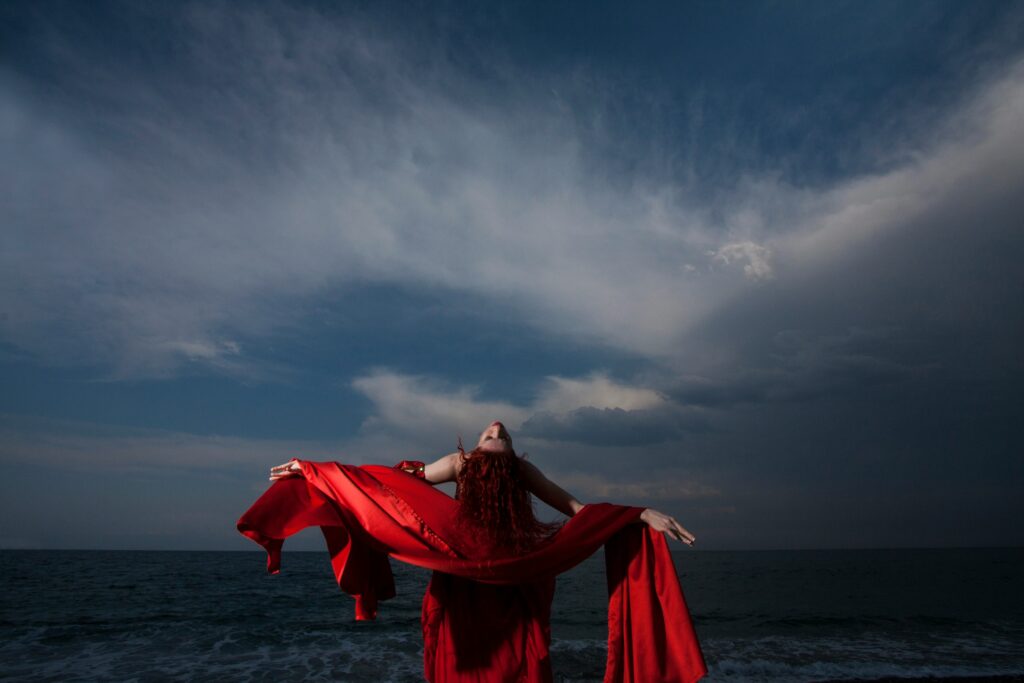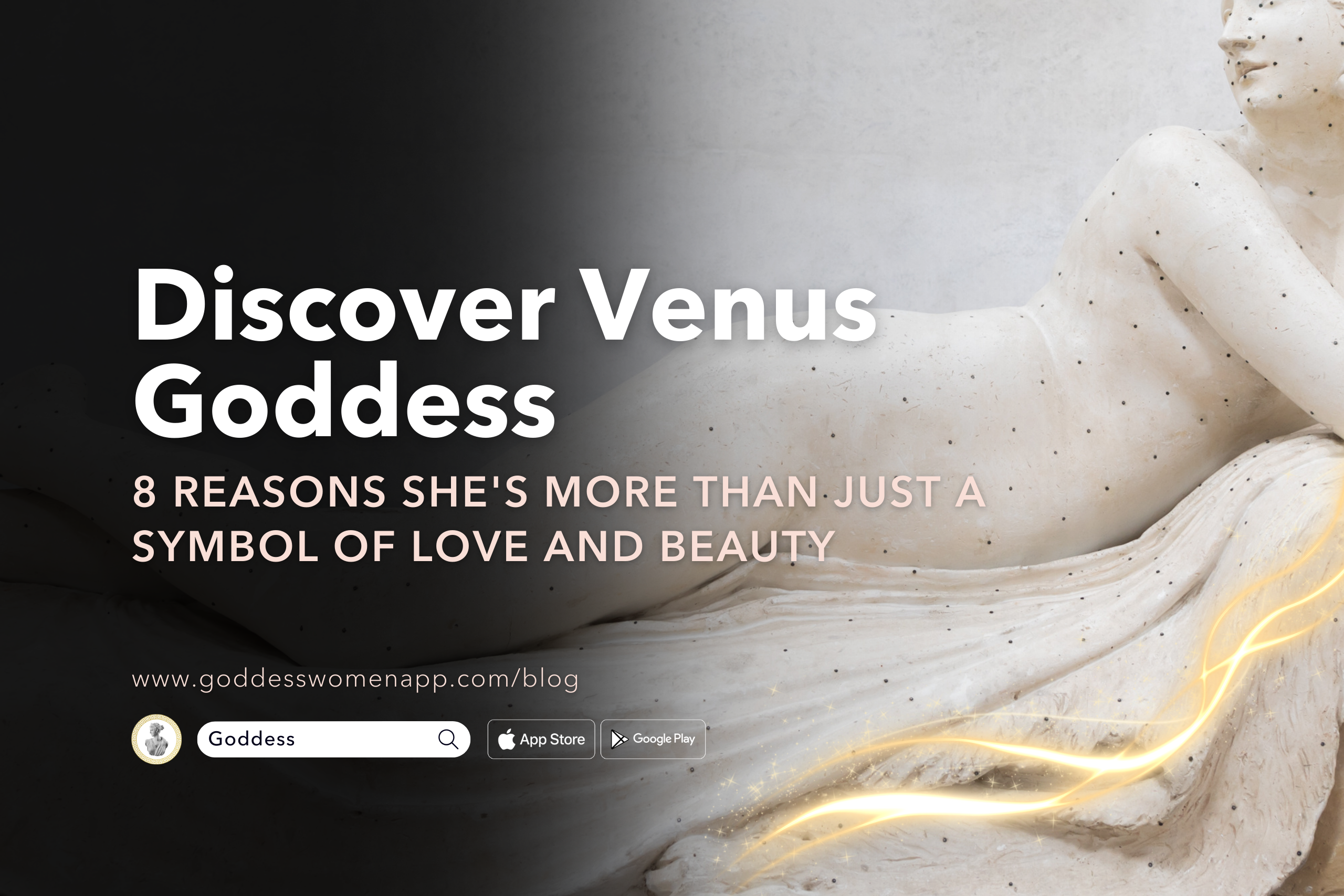Table of Contents
Introduction
When you think of Venus, the image that likely springs to mind is one of unparalleled beauty, a deity draped in the finest robes, embodying love, desire, and all the captivating allure that the heart yearns for. But to pigeonhole Venus as merely a symbol of love and beauty does a disservice to the depth and breadth of her influence.
Venus, or Venus Goddess as she’s reverently known, stands as a testament to the complexity and richness of ancient mythology, serving roles that transcend the conventional boundaries of love and aesthetics. In this exploration, we delve into the multifaceted persona of Venus Goddess, uncovering eight compelling reasons why she is much more than just an icon of love and beauty. From her auspicious role as Venus Felix to her revered status as Venus Genetrix, we invite you on a journey through time and myth, revealing the layers that compose this immortal deity.

1. Venus Goddess: The Embodiment of Love and Beauty
At her core, Venus Goddess reigns as the quintessence of love, beauty, and fertility. This portrayal is far from superficial; it’s deeply woven into the fabric of human culture and consciousness, representing the innate human desires for connection, appreciation, and creation. Venus’s emblematic association with these domains has been celebrated through centuries, immortalized in countless works of art, from the ancient statues that capture her divine form to Renaissance paintings that depict her in all her ethereal glory.
Venus’s role as the embodiment of beauty isn’t merely about physical appearance; it extends to the beauty of the soul, the allure of harmony, and the grace of the natural world. Her connection to love encompasses all its forms, from the passionate love of lovers to the affection between friends and the care within families. Moreover, her domain of fertility goes beyond human reproduction, touching on the fertility of the earth and the seasons, embodying the cycle of life and renewal.
Artists and poets throughout history have been inspired by Venus, seeing in her a muse that represents the highest ideals of beauty and love. Works like Botticelli’s “The Birth of Venus” not only celebrate her physical beauty but also symbolize the birth of beauty and creativity in the world. Similarly, in literature, Venus has been a character of intrigue and inspiration, from ancient Roman poetry to Shakespeare’s plays, where she often plays a role in guiding the fates of lovers and stirring the passions of the heart.
Venus’s influence extends beyond the confines of mythology into the realm of astrology, where she governs love, beauty, harmony, and the things we value most. Her significance in astrology reflects her cultural and mythological importance, influencing how we understand ourselves and our relationships.
In sum, Venus Goddess’s association with love and beauty is foundational, not only defining her character within the pantheon of gods and goddesses but also reflecting humanity’s perennial pursuit of harmony, pleasure, and aesthetic fulfillment. This aspect, though well-known, is just the beginning of the vast and intricate tapestry that makes up the goddess’s identity and legacy.

2. Venus Felix: Bringer of Good Fortune
In the grand tapestry of Roman mythology, Venus Felix, or “Lucky Venus,” emerges as a beacon of optimism and prosperity. This aspect of the Venus goddess transcends her foundational domain of love and beauty, casting her as a divine emblem of good fortune and felicity. Unlike her Greek counterpart, Aphrodite, who predominantly presides over love and erotic beauty, Venus in her Roman guise accumulates a broader spectrum of influences, with Venus Felix highlighting her capacity to bring luck and happiness to those who revere her.
Historically, the Roman religion was intricately connected with the state’s welfare, with deities like Venus playing a pivotal role in the public and private lives of the Roman people. Venus Felix was worshipped not just as a personal guardian of luck but also as a patron goddess of Rome’s prosperity. This veneration was encapsulated in the numerous temples dedicated to her, such as the magnificent temple of Venus Felix on the Via Sacra, which stood as a testament to her esteemed position among the major Roman deities.
One of the most significant historical instances that underscore Venus’s role as a bringer of good fortune was her affiliation with Julius Caesar. Caesar, claiming descent from the Trojan hero Aeneas, son of Venus, elevated the goddess to a celestial status, Venus Genetrix, thereby intertwining the fate of Rome with the divine favor of Venus. This conflation of Venus’s roles—as Felix and Genetrix—reinforced her image as a protector and benefactor of the Roman state and its people.
Rituals and festivals dedicated to Venus Felix were integral to Roman religion, serving as communal expressions of hope for prosperity and protection against misfortune. The worship of Venus encompassed various forms, from public offerings and celebrations at her temples to private rituals aimed at invoking her favor. The cult of Venus Felix, particularly, reflected the Roman populace’s aspirations for happiness and success, both in personal endeavors and the collective well-being of the Empire.
Venus’s epithets, such as Venus Victrix and Venus Verticordia (“Venus the Changer of Hearts”), further reveal her capability to influence and transform. Beyond mere luck, Venus Felix encompassed the idea of positive change—transforming ill fortune into favorable outcomes, guiding Rome through periods of turmoil and triumph. Her worship was not confined to the elite; it permeated all strata of Roman society, from the soldiers praying for victory to farmers seeking bountiful harvests, and even to lovers hoping for her blessing.
In the broader context of Roman religion, Venus Felix stood alongside other major deities, embodying the Roman Empire’s complex religious landscape, where gods and goddesses were called upon for their specific powers and patronage. Venus, with her myriad aspects, represented the ideal of divine intervention in the mortal world, offering protection, inspiration, and, most importantly, hope for good fortune.
Through the veneration of Venus Felix, ancient Rome laid siege to the capricious whims of fate, entrusting their city’s destiny to the purifying and lucky embrace of Venus. Whether in the Circus Maximus or within the sanctified confines of her temples, Venus was celebrated, her divine favor sought after as both the ultimate purifier and the grand bringer of luck. In celebrating Venus Felix, Romans acknowledged the goddess’s power to not only inspire love and beauty but to fundamentally alter the course of their lives and their city for the better, making Venus a central figure in the spiritual and cultural identity of eternal Rome.

3. Venus Genetrix: The Mother of Rome
In the heart of ancient Rome, amidst the echoes of its eternal glory, Venus Genetrix emerges as a foundational figure, not merely a goddess of love and beauty but a divine ancestor and protector of the Roman people. This facet of Venus, as “Mother Venus,” cements her position within Roman religion and history, transcending her other aspects to embody the very essence of Roman identity and destiny.
The invocation of Venus Genetrix is a testament to the profound connection between the divine and the foundational myths of Rome. This connection was significantly amplified by Julius Caesar, who, claiming descent from the Trojan hero Aeneas, the son of Venus, established a new forum and dedicated a magnificent temple to Venus Genetrix. This act was not only a political maneuver but also a spiritual declaration, placing Venus at the heart of Roman statehood and its people’s lineage. Caesar’s association with Venus elevated her status to that of a patron goddess, intertwining her divine favor with the prosperity and victory of the Roman Empire.
The cult of Venus Genetrix transcended the bounds of personal worship to become a state-sanctioned veneration, celebrating Venus not just as a bringer of erotic beauty or earthly pleasure but as a guarantor of Rome’s imperial might and familial bonds. Her temple in Rome’s Forum Iulium became a symbol of this sacred bond, a focal point where the divine and the mortal coalesced, reinforcing the social and political fabric of the Roman state.
Rome’s Venus Genetrix was not only a spiritual mother but also a symbol of Roman virtue and fertility. Her depiction in art and sculpture, such as the renowned Venus de Milo, although more commonly associated with her Greek counterpart Aphrodite, reflects the idealized beauty and maternal grace that Venus Genetrix represented. These images served as constant reminders of her role as the progenitor of the Roman people and their divine protector.
The worship of Venus Genetrix also included rituals and ceremonies that highlighted her role as a motherly figure. The Vestal Virgins, Rome’s priestesses, played a significant role in these rites, maintaining the eternal flame in her temple as a symbol of the city’s everlasting life and prosperity. This connection between Venus and the Vestal Virgins underscored her importance in Roman religion, embodying purity, protection, and the continuity of the state.
Venus Genetrix’s influence extended into the realm of literature, where Roman poets like Virgil in his “Aeneid” and Ovid in “Metamorphoses” celebrated her as the divine ancestor of the Roman people. Through their epic tales, Venus’s role as the mother of Aeneas, and thereby the progenitor of Rome, was immortalized, weaving her into the very fabric of Roman mythology and history.
In classical mythology, Venus’s roles are manifold, but as Venus Genetrix, she occupies a unique place in the pantheon of Roman deities. This aspect of Venus underscores the Romans’ ability to adapt and integrate aspects of Greek Aphrodite into their religious and cultural identity, while also infusing her with attributes that reflected the values and aspirations of Roman society.
As the Mother of Rome, Venus Genetrix symbolized the unity and strength of the Roman Empire, embodying the ideals of divine ancestry and protection. Her veneration as Venus Genetrix served as a constant reminder of the Romans’ divine origins, their strength, and their enduring legacy, making her an eternal symbol of Rome’s greatness and its people’s unbreakable bond with the divine.

4. Venus Erycina: Protector of Rome
Venus Erycina, a lesser-known but equally significant guise of the Venus goddess, highlights her role as a formidable protector of Rome. Unlike the gentle Venus Felix or the nurturing Venus Genetrix, Venus Erycina embodies the strength and strategic prowess necessary to safeguard the Roman Empire from its adversaries. This aspect of Venus illustrates the adaptive and multifaceted nature of Roman religion, where deities often held complex and varied roles within the pantheon.
The origin of Venus Erycina’s veneration in Rome can be traced back to the aftermath of the Punic Wars, a series of devastating conflicts that challenged the very foundation of Roman power. Seeking divine intervention and protection, the Romans looked to Venus Erycina, whose cult was introduced from the Sicilian city of Eryx, thereby integrating her into the Roman pantheon as a guardian deity. Her temples, such as the one established on the Capitoline Hill, served not only as places of worship but also as symbols of Rome’s resilience and divine favor.
As Protector of Rome, Venus Erycina was invoked by soldiers and generals alike, her favor sought to ensure victory in battle and to maintain the peace and stability of the Roman state. This martial aspect of Venus might seem at odds with her more commonly recognized domains of love and beauty, yet it reflects the Roman ethos of divine patronage extending to all aspects of life, from the intimate to the communal, from the creation of life to the protection of the nation.
The worship of Venus Erycina included rituals and sacrifices intended to appease her martial spirit and secure her blessings. These ceremonies often took place before military campaigns, with offerings made in her temples to gain her protective grace. The inclusion of Venus Erycina in these solemn rites underscores her importance not just as a goddess of personal desire, but as a crucial figure in the public and political sphere, embodying the Romans’ hope for divine protection against external threats.
Artistically, Venus Erycina’s depiction often merged her sensual beauty with martial elements, symbolizing her dual role as a goddess of love and a protector. While not as prevalent in art as Venus Genetrix or the Venus de Milo, her representations nonetheless contributed to the rich tapestry of Roman religious iconography, illustrating the seamless blend of the erotic and the protective, the indulgent and the vigilant.
The integration of Venus Erycina into Roman religion and society also highlights the syncretic nature of Roman religious practices. By adopting and adapting the worship of foreign deities, such as Venus from her Greek counterpart Aphrodite, the Romans not only expanded their pantheon but also reinforced the cultural and spiritual resilience of their empire. Venus Erycina, therefore, stands as a testament to the dynamic and evolving nature of Roman deity worship, where pagan gods, and goddesses served multiple, often overlapping roles within the fabric of Roman life.
Moreover, the cult of Venus Erycina reflects the Romans’ understanding of the divine as both immanent and transcendent, capable of influencing the course of human affairs in profound ways. Her veneration as a protector against the uncertainties of war and conflict exemplifies the Romans’ reliance on their deities not just for personal fulfillment but for the collective well-being and success of their society.
In summary, Venus Erycina, as Protector of Rome, embodies the strength, strategy, and protective grace that safeguarded the Roman Empire through its trials. Her worship underscores the multifaceted nature of Venus as a deity, revealing a goddess who is not only the embodiment of love and beauty but also a formidable guardian of her people. Through Venus Erycina, the Romans celebrated the divine protection that ensured their survival and prosperity, weaving her into the storied legacy of the ancient world and its enduring deities.

5. Roman Venus: Integration with Greek Aphrodite
The Roman Venus, a figure of love, beauty, and fertility, is not solely a product of Latin invention. Her origins, deeply intertwined with the Greek goddess Aphrodite, exemplify the cultural and religious syncretism that characterized the ancient world. The integration of Venus into Roman religion was a nuanced process, blending the Venus goddess’s native attributes with those of her Greek counterpart, Aphrodite, leading to a deity that encapsulated the values and aspirations of both cultures.
Syncretism and Cultural Exchange
The adoption of Greek Aphrodite’s characteristics by the Roman Venus underscores the open exchange between Greek and Roman societies. This syncretism was not merely a case of adopting a deity but rather integrating and reinterpreting her attributes to fit the Roman context. Venus’s evolution from a garden goddess to a major Roman deity of love, erotic beauty, and motherhood reflects this blending of influences, creating a goddess who was both familiar and uniquely Roman.
Artistic Representations: From Venus de Milo to Sandro Botticelli
Artistically, the fusion of Venus and Aphrodite is most vividly seen in the realm of sculpture and painting. The Venus de Milo, an iconic marble statue from Hellenistic art, embodies the idealized form of beauty that influenced Roman representations of Venus. This classical influence extended into the Renaissance, notably in Sandro Botticelli’s “Birth of Venus,” which drew upon ancient motifs to depict the goddess emerging from sea foam, a scene that mirrors the mythological birth of Aphrodite.
Literary Reflections: Ovid’s Metamorphoses and Virgil’s Aeneid
In literature, the narratives surrounding Venus and Aphrodite merged seamlessly. Ovid’s “Metamorphoses” and Virgil’s “Aeneid” integrated the stories of the Greek Aphrodite with the Roman Venus, portraying her not just as a goddess of love but as a pivotal figure in the fate of Rome. Virgil, in particular, emphasized Venus’s role as the mother of Aeneas, the Trojan hero and legendary founder of the Roman people, thus weaving her into the very fabric of Roman state identity.
The Religious Context: Venus Verticordia and Venus Libitina
In the religious practices of ancient Rome, Venus assumed multiple roles beyond those inherited from Aphrodite. As Venus Verticordia, she was the changer of hearts, protector of marital fidelity, and guide in matters of love. Another aspect, Venus Libitina, linked her with funerary rites, showcasing the goddess’s influence over both the beginning and end of life. These roles, distinctly Roman, highlighted the goddess’s versatility and her integration into every aspect of public and private life.
Temples and Worship: Venus’s Sacred Spaces
The construction of temples dedicated to Venus, such as Rome’s Venus Genetrix and Venus Erycina, further signified her importance within Roman religion. These magnificent temples not only served as places of worship but also as symbols of the Roman Empire’s power and its divine sanction. The rituals and festivals held in honor of Venus, including her oldest festival, Veneralia, underscored her significance in the Roman calendar, celebrated with fervor across the empire.
Conclusion: A Goddess for All Seasons
The integration of Greek Aphrodite into Roman Venus represents a fascinating instance of cultural syncretism, where two civilizations blended their deities to create a goddess who transcended the boundaries of classical mythology to become a symbol of universal values. Venus, with her multifaceted roles and attributes, emerged as a deity of unparalleled importance in ancient Rome, embodying the complexities of love, beauty, and human relationships. Through this integration, Venus retained her core essence while evolving to meet the needs and reflect the values of Roman society, making her a timeless figure of worship and admiration in the pantheon of ancient deities.

6. Venus and Her Divine Family Connections
Venus, in her celestial tapestry, is intricately woven into the fabric of divine lineage and relationships that underscore her significance within Roman and Greek mythology. As the goddess of love and beauty, Venus (or Aphrodite in Greek mythology) boasts a lineage that ties her to major Roman deities and heroes, illustrating the interconnectedness of mythological narratives.
The Birth of Venus and Her Divine Lineage
Venus’s origin story is a tale of cosmic beauty: born from the sea foam (according to Hellenistic tales), she is said to have emerged fully formed, a symbol of perfect beauty and grace. This miraculous Venus birth ties her to the primordial elements of nature, establishing her as a deity of both elemental power and profound attraction to mortal woman.
Connections with Major Deities
Venus’s familial ties extend to the Olympian gods: she is often depicted as the daughter of Jupiter (the Roman king of the gods) and Dione (a figure whose roots may lie in the Greek goddess tradition). These connections position her among the pantheon’s elite, highlighting her importance in the celestial hierarchy.
The Love Affairs of Venus
Venus’s romantic entanglements with gods and mortals are legendary. Her relationships with Mars, the god of war, and Vulcan, the god of fire and craftsmanship, showcase the goddess’s influence over the hearts of both deities and humans alike. These divine relationships with mortal lovers symbolize the power of love to transcend the boundaries between the mortal and the immortal, the peaceful and the warlike.
Venus’s Offspring
Notable among Venus’s children is Cupid (Eros in Greek mythology), the god of desire, erotic love, attraction, and affection for young woman. Cupid’s role in mythological tales, often depicted with his mother, emphasizes Venus’s domain over love and beauty, extending her influence through her descendants.

7. Venus’s Temples and Worship: A Testament to Her Influence
The worship of Venus in ancient Rome was marked by the construction of splendid temples and the performance of elaborate rituals, a testament to her enduring influence and revered status among the Roman deities.
Temples Dedicated to Venus
The most magnificent temple dedicated to Venus was the Temple of Venus Genetrix, located in the Forum of Caesar. This temple not only honored her as the divine ancestor of the Julian lineage but also served as a center of worship for her protective and nurturing aspects. Other temples, like those dedicated to Venus Erycina and Venus Verticordia, highlight her diverse roles within Roman society.
Rituals and Festivals
Venus’s oldest festival, Veneralia, celebrated on April 1st, was dedicated to Venus Verticordia and Venus Felix. It was a day when women sought the goddess’s blessings for personal beauty and marital fidelity. The rituals performed in Venus’s temples, ranging from public offerings to private supplications, underscored her integral role in the everyday lives of Romans, influencing everything from personal relationships to state affairs.
8. Venus in Modern Culture: A Timeless Icon
Venus’s legacy extends far beyond the ancient world, permeating modern culture in myriad ways. Her image and mythology continue to inspire artists, writers, and scholars, cementing her status as a timeless icon of love and beauty.
Artistic Legacy
From the classical depictions in the works of Sandro Botticelli to modern interpretations in art and sculpture, Venus remains a favorite muse. Her image, symbolizing divine beauty and human desire, continues to captivate audiences, evident in the countless artistic renditions and references to her mythos throughout modern art history.
Literary Inspirations
Venus’s influence in literature can be traced from Roman poets to contemporary writers. The themes of love, beauty, and the complexities of human relationships she represents find echoes in literature across the ages, from Ovid’s “Metamorphoses” to modern novels and poetry.
Cultural Icon
In popular culture, Venus has transcended her mythological origins to become a symbol of beauty and love in the collective imagination. From fashion brands to literary metaphors, her name and image evoke the timeless allure and complexity of the feminine, demonstrating her enduring relevance.
In sum, Venus’s evolution from an ancient deity of love and beauty to a modern cultural icon underscores her unbroken appeal and influence. Her divine family connections, the majestic temples dedicated to her worship, and her omnipresence in modern culture all testify to the lasting legacy of Venus, a goddess who continues to inspire and captivate humanity’s imagination.
Conclusion
In the spirit of exploring and embracing the divine within, we invite you to connect with your own inner goddess through the Goddess App. Just as Venus has inspired generations, this app offers a unique opportunity for women to discover the goddess archetype that resonates with their spirit and journey. Whether you’re drawn to the allure of Venus, the wisdom of Athena, or the resilience of Artemis, the Goddess App is your gateway to uncovering the powerful attributes and timeless stories that mirror your own.
Discover. Connect. Empower. Find your goddess archetype and embrace the divine within you.





